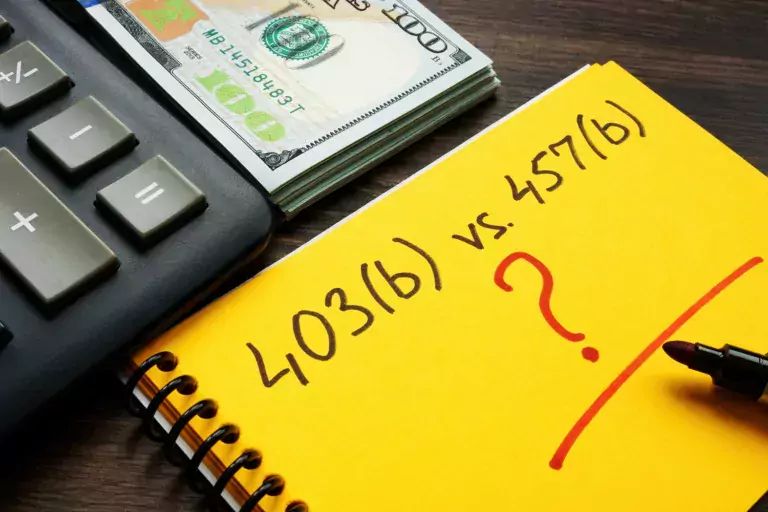Can you use a 403(b) and a 457(b) together?
In this article, let’s review who can have 403(b) and 457(b) retirement plans. We’ll cover the account rules and whether you can max out both accounts in the same year.
What is a 403(b)?
If you’ve ever wondered why many retirement plans (except for the individual retirement account or IRA) have such strange names, they come from numbered sections of the IRS tax code that created them. A 403(b) is a sister account to the well-known 401(k) retirement plan, with a few differences.
Both accounts allow workers to save for retirement; however, a 401(k) is only available for private-sector companies. But tax-exempt organizations, like public schools, universities, hospitals, churches, and nonprofit entities, can offer their workers a 403(b).
Compared to a 401(k), the investment options in a 403(b) may be somewhat limited; however, they often include annuity contracts. In fact, years ago, they were known as a “tax-sheltered annuity” or TSA. Another difference is that a 403(b) often has a faster vesting schedule than a 401(k), allowing employees to fully own employer matching or profit-sharing funds more quickly.
For 2023, you can contribute up to $22,500 or $30,000 if you’re over 50 to either a 401(k) or a 403(b) if you have multiple employers. That’s because the annual limit gets aggregated for these plan types. Some 403(b)s may even allow additional catch-up contributions for those over 50 with 15 or more years of service with their employer.
A 401(k) and 403(b) allow traditional and Roth contributions. Traditional contributions are tax-deductible, and earnings grow tax-deferred until you make withdrawals in retirement. Roth contributions get taxed upfront (nondeductible), and you can withdraw them plus earnings tax-free in retirement.
How do you save for retirement and get all the benefits you’ve earned? Having more than one plan can change the tax rules and benefits you receive. Laura explains how to get most most out of multiple retirement accounts in the same year. Listen in the player below.
What is a 457(b) retirement plan?
Now, let’s talk about a 457(b) retirement plan, which has key differences from a 403(b) and 401(k). First, a 457(b) is typically only available to workers of state and local governmental agencies.
Note that there’s also a 457(f), which tax-exempt organizations can offer to executives or highly compensated employees. But we’ll only cover rules for the 457(b) here.
For 2023, you can contribute the same amount to a traditional or Roth 457(b) as most other workplace retirement plans: $22,500 or $30,000 if you’re over 50. However, the annual limit doesn’t get aggregated with different plan types; it stands independently. In addition, three years before your declared retirement age, you may be eligible to double the standard contribution limit.
For instance, for 2023, the 457(b) catch-up provision could make you eligible to contribute $45,000 ($22,500 x 2). The catch-up amount depends on how much you contributed in previous years. It allows you to make up for years when you didn’t max out the plan. So be sure to get guidance from your 457 benefits administrator when you approach your desired retirement age so you can contribute the highest possible amount.
Another benefit of a 457(b) is that it doesn’t impose a 10% early withdrawal penalty if you leave your job and are younger than 59.5 (like with other types of retirement plans). You still must pay income tax on withdrawals that weren’t previously taxed.
Where should you invest for retirement after maxing out a 401(k)? Learn gives seven places to put your money and grow a cushy retirement nest egg. Listen in the player below.
Who qualifies for a 403(b) and a 457(b)?
While some employers only offer a 457(b), workers in higher education typically get both a 457(b) and a 403(b). And when both are available, you can max out both accounts, an excellent way to supercharge your retirement savings! That’s possible because, as I mentioned, the 457(b) contribution limit doesn’t get aggregated with other account limits.
For 2023, when you have a 457(b) and a 403(b) and are under 50, you could contribute $22,500 to each, for a total of $45,000. If you’re over 50, you could put $30,000 in each plan for a total of $60,000.
If you’re over 50 and your 457 has a three-year catch-up provision, you could put $45,000 in it and $30,000 in your 403(b), for a total of $75,000. And if you’ve worked for your employer for at least 15 years, you may be eligible to contribute more to the 403(b), depending on what your plan allows.
Note that any retirement plan’s contributions are limited to 100% of your compensation. So, if your gross wages are less than the maximum limit, you can only contribute an amount equal to your wages for the year.
What’s the best strategy for a 403(b) and a 457(b)?
If you’re fortunate enough to have a 403(b) and a 457(b), max out the 403(b) first and then contribute to the 457. That’s because the 403(b) is likely to have a match if you’re not eligible for a pension.
But maxing out your 457 first is likely best if you have a pension. However, I recommend consulting with a financial advisor for the best strategy to maximize your benefits based on your goals, any employer contributions, and other retirement accounts you may be using.
You have some excellent employee benefits if you work for your state or local government. And if you work for a public school, college, or university, you may be able to max out a 403(b) and 457(b) plan, effectively doubling your tax-advantaged retirement savings.




